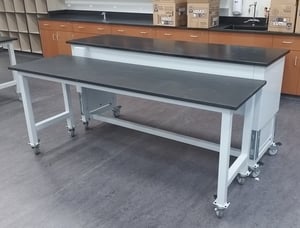Potential dangers are a way of life in industrial workspaces, between the heavy machinery and intricate processes. These dangers often spur extensive safety guidelines that are meant to protect workers in these demanding environments.
Yet it can be easy to overlook one of the areas that causes a significant number of injuries each year in the workplace. Musculoskeletal disorders are the single largest category of workplace injuries in the United States and account for nearly 30% of all workers’ compensation costs, according to the Bureau of Labor Statistics (BLS).
Musculoskeletal disorders, or MSDs, affect the muscles, nerves, blood vessels, ligaments and tendons. Many different types of workers can be at risk for developing MSDs, though in manufacturing, laboratory and industrial settings, employees are at risk if they lift heavy items, bend or reach overhead, push or pull heavy loads, work in awkward body postures, or perform the same or similar tasks over and over.
While there are different types of safety equipment and rules available to help avoid workplace injuries, the solutions to preventing MSDs often fall in where employees work. For example, if your workers spend much of their days at industrial benches, the design of the bench can play an important role in keeping employees safe.
And because musculoskeletal disorders can significantly impact other layers of production, including the efficiency and productivity of employees, the industrial workbench you choose can affect several areas of your operation.
So how do you design an industrial bench with greater safety and productivity in mind?
Focus On The Workbench Height
One of the most effective methods to focusing on employee safety when designing a workbench is to allow the worker to adjust the height of the work surface. Adjustable workbenches rise and lower based on the comfort level of the employee.
the worker to adjust the height of the work surface. Adjustable workbenches rise and lower based on the comfort level of the employee.
The type of lift mechanism you choose determines how this motion is accomplished. A slot adjustment bench allows an employee to raise the work bench legs by removing bolts and spacers. While the end result is ergonomically-friendly since the worker using the bench has moved the tabletop to a comfortable height, the process by which the worker gets there isn’t as friendly since the employee has to manually lift the bench.
Another option is a hand crank adjustable height workbench. This type of workbench is also manual in design, but a hand crank makes it much easier for workers to lift and lower the bench unless there are heavy objects on the bench.
A similar alternative, a hand crank workbench with hydraulic features, takes care of this problem above. This type of bench uses hydraulic fluid in the cylinders to force the shafts in the workbench legs to elevate. Depending on the workbench you choose, workers may be able to lift up to 1,000 pounds. However, the downside to this type of bench is that you may have to worry about oil leaks that may come with heavy use over time.
Your final option is an electric adjustable height workbench. This design offers the highest level of ergonomic support because an employee simply pushes a button to lift or lower the surface. This style can also lift heavy objects. However, electric adjustable height workbenches tend to price higher than other types, and they must be located near an outlet.
Provide Ample Storage Space
Productivity hinges on having ample storage space to maintain organization of the many tools and accessories found in industrial settings. It’s important to keep in mind as well that how you set up these storage configurations can impact how ergonomically-friendly an industrial bench is to workers.
Purchasing industrial benches from an office store or in bulk won’t offer the same customization opportunities as an industrial furniture company will.
For example, your employees might benefit from eight smaller 3-inch drawers if they have several tools that need to be kept organized and separated for quick retrieval. In that same space, however, you can fit four 3-inch drawers and one 12-inch drawer.
While configurations can help fulfill your storage needs, design elements like full extension and heavy duty roller bearing slides can make opening and closing these drawers effortless.
Other design features to consider for optimal storage and organization include:
- A lab bench shelf that can be customized to hold as much as 300 pounds
- Articulating monitor arms that can hold flat screens and laptops
- Keyboard trays that can free up counter space
- CPU holders that can be fixed or adjustable
- Pegboards that can hold tools
- Bin rails or panels to store parts and accessories
With the right design, the organizational needs of your staff can be met to keep productivity at a high level.
Don’t Forget Electrical Needs
Particularly lighting needs are an important consideration for both safety and productivity. Above-head lighting and under-shelf bulbs can properly illuminate spaces, while strategically-placed electrical strips, outlets and USB ports can provide additional lighting sources.
lighting and under-shelf bulbs can properly illuminate spaces, while strategically-placed electrical strips, outlets and USB ports can provide additional lighting sources.
Emergency power sources are another accessory to consider to ensure safety if an electrical outage occurs.
In environments where electronic devices are used, industrial benches with built-in wireless charging pads and dedicated charging compartments can ensure that tools and devices remain charged and ready for use. Some benches can even be equipped with battery management systems to optimize charging and extend battery life.
Invest In ESD Technology
Electrostatic discharge (ESD) occurs when two objects rub together and one object gives up electrons to another object. This causes one to become more positively charged while the other object becomes more negatively charged, creating a charge imbalance once the two materials or products separate.
These charges then may build up on an object’s surface until they find a way to be discharged. In industrial workspaces, static electricity can interfere with weighing accuracy, cleanroom specifications and safety requirements.
If your facility can be impacted by ESD, it’s critical to invest in technology that can help dissipate this compromising source. ESD isn’t limited to electronics manufacturers either. Many different types of industries have issues with ESD, from pharmaceutical to agriculture, printing and graphic arts, plastics and electronics manufacturers.
Industrial benches that are constructed using ESD laminate surfaces can help dissipate any static that is generated. This work surface is made of high pressure laminate with a carbon layer. As an added benefit, ESD laminate surfaces are also resistant to staining and chemicals that include acetone, gasoline and 10% ammonium solutions.
An ESD chair, which is manufactured with high-quality non-flammable ESD fabrics and vinyls, can further protect your environment from electrostatic discharges.
Top Off Your Design With These Final Touches
A few final touches can take safety and productivity to the next level for your employees.
Footrest Tube And Pan
A footrest tube is a steel bar that is mounted between the legs on opposite sides of the bench. A footrest pan is made of steel tubing and includes a steel pan that can be tilted up or down for an operator’s comfort. The pans often include non-slip friction tape.
Both increase the comfort of a worker, while offering safety features like the non-slip friction tape.
Freestanding Footrest
A freestanding footrest connects to the leg, but has independent adjustments for the foot pan height and angle. A freestanding footrest is often used in clean room applications.
This type of footrest also provides ergonomic support by allowing users to adjust their foot position and elevation, promoting proper posture and reducing strain on the lower back and legs.
Casters
Mobile workstation furniture features casters that give furniture their mobile ability. They boost productivity in spaces where workbenches need to be quickly and easily moved. They also boost employee health and safety since workers don’t have to lift workstations to move them to another space.
Make sure you purchase casters that match the weight load capacity of your bench. In industrial settings, casters should have a weight load capacity of closer to 1,000 pounds when using all four casters.


